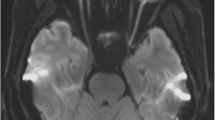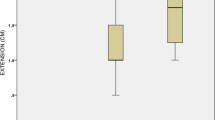Abstract
Objectives
To evaluate the usefulness of the signal intensity ratio (SIR) of the optic nerve to the white matter (WM) on short tau inversion recovery (STIR) images to diagnose acute optic neuritis (AON).
Methods
The 405 consecutive patients with suspected orbital diseases underwent orbital magnetic resonance imaging (MRI) using a 3-T scanner between June 2008 and August 2011. Among them, 108 optic nerves (33 AON and 75 control) were retrospectively analysed. The averaged SIR (SIRave) and maximum SIR (SIRmax) were defined as the averaged signal intensity (SI) of the optic nerve divided by that of WM, and the maximum SI of the optic nerve divided by averaged SI of WM, respectively. These values were compared between AON and control using the Mann–Whitney U test. A P < 0.05 was considered statistically significant.
Results
SIRave and SIRmax were significantly (P < 0.001) higher in the AON compared to the control. At a cut-off SIRave value of 1.119, the sensitivity, specificity and accuracy were 0.939, 0.840, and 0.870; and at a cut-off SIRmax value of 1.281, these were 1.000, 0.720 and 0.806, respectively.
Conclusion
The SIR of the optic nerve to WM on STIR images is of value in diagnosing AON.
Key Points
• We propose a method of diagnosing acute optic neuritis using 3-T MRI.
• Our method is simple and objective and requires no novel imaging techniques.
• Our method shows high diagnostic accuracy.





Similar content being viewed by others
Abbreviations
- AON:
-
acute optic neuritis
- IFWM:
-
ipsilateral frontal white matter
- ON:
-
optic neuritis
- SI:
-
signal intensity
- SIR:
-
signal intensity ratio
- SIRave:
-
averaged signal intensity ratio
- SIRmax:
-
maximum signal intensity ratio
- STIR:
-
short tau inversion recovery
- VEP:
-
visual evoked potential
- WM:
-
white matter
References
Optic Neuritis Study Group (1991) The clinical profile of optic neuritis. experience of the optic neuritis treatment trial. Arch Ophthalmol 109:1673–1678
Gass A, Moseley IF (2000) The contribution of magnetic resonance imaging in the differential diagnosis of optic nerve damage. J Neurol Sci 172:S17–S22
Johnson G, Miller DH, MacManus D et al (1987) STIR sequences in NMR imaging of the optic nerve. Neuroradiology 29:238–245
Miller DH, Newton MR, van der Poel JC et al (1988) Magnetic resonance imaging of the optic nerve in optic neuritis. Neurology 38:175–179
Atlas SW, Grossman RI, Hackney DB, Goldberg HI, Bilaniuk LT, Zimmerman RA (1988) STIR MR imaging of the orbit. AJR Am J Roentgenol 151:1025–1030
Miller DH, Johnson G, McDonald WI et al (1986) Detection of optic nerve lesions in optic neuritis with magnetic resonance imaging. Lancet 1:1490–1491
Tartaro A, Onofrj M, Delli Pizzi C et al (1996) Long time echo STIR sequence magnetic resonance imaging of optic nerves in optic neuritis. Ital J Neurol Sci 17:35–42
Hanawa T, Mizota A (2007) Quantitative evaluation of signal intensity of magnetic resonance images in optic neuritis. Open Ophthalmol J 1:1–3
Jackson A, Sheppard S, Laitt RD, Kassner A, Moriarty D (1998) Optic neuritis: MR imaging with combined fat- and water-suppression techniques. Radiology 206:57–63
van der Walt A, Kolbe S, Mitchell P et al (2015) Parallel changes in structural and functional measures of optic nerve myelination after optic neuritis. PLoS One 10, e0121084
Kupersmith MJ, Alban T, Zeiffer B, Lefton D (2002) Contrast-enhanced MRI in acute optic neuritis: relationship to visual performance. Brain 125:812–822
Weigel M, Lagreze WA, Lazzaro A, Hennig J, Bley TA (2006) Fast and quantitative high-resolution magnetic resonance imaging of the optic nerve at 3.0 tesla. Invest Radiol 41:83–86
Acknowledgements
The scientific guarantor of this publication is Masamitsu Hatakenaka MD, PhD. The authors of this manuscript declare no relationships with any companies whose products or services may be related to the subject matter of the article. The authors state that this work has not received any funding. One of the authors has significant statistical expertise. Institutional review board approval was obtained. Written informed consent was waived by the institutional review board.
No study subjects or cohorts have been previously reported. Methodology: retrospective, diagnostic or prognostic study, performed at one institution.
Author information
Authors and Affiliations
Corresponding author
Rights and permissions
About this article
Cite this article
Onodera, M., Yama, N., Hashimoto, M. et al. The signal intensity ratio of the optic nerve to ipsilateral frontal white matter is of value in the diagnosis of acute optic neuritis. Eur Radiol 26, 2640–2645 (2016). https://doi.org/10.1007/s00330-015-4114-4
Received:
Revised:
Accepted:
Published:
Issue Date:
DOI: https://doi.org/10.1007/s00330-015-4114-4




